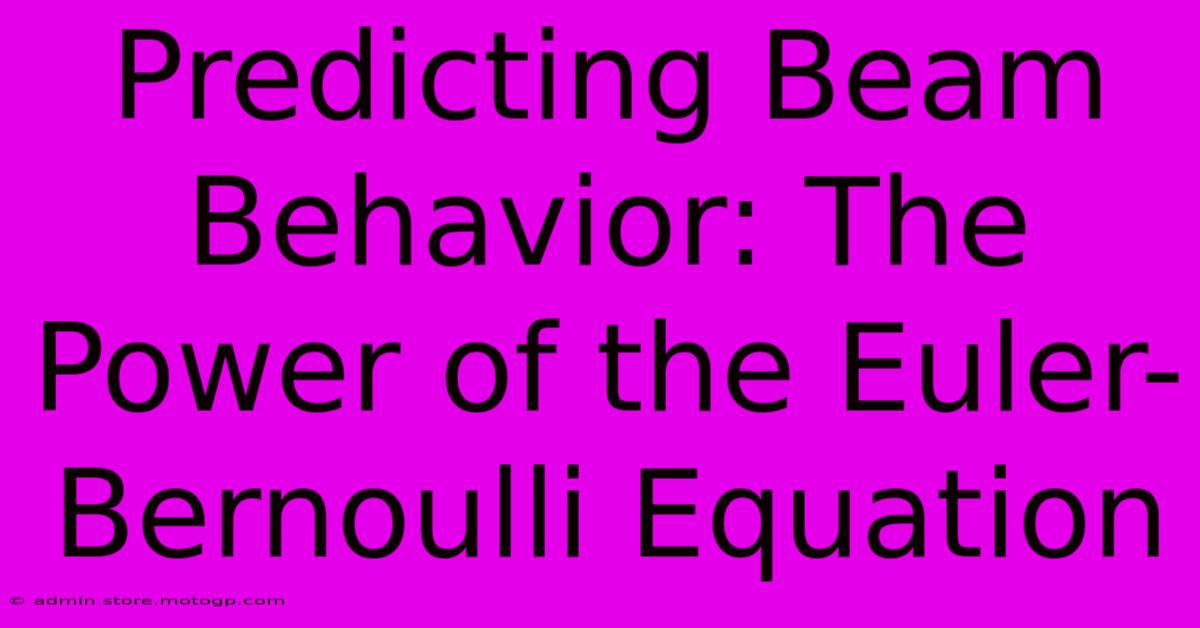Predicting Beam Behavior: The Power Of The Euler-Bernoulli Equation

Table of Contents
Predicting Beam Behavior: The Power of the Euler-Bernoulli Equation
Understanding how beams behave under load is crucial in various engineering disciplines, from civil and mechanical engineering to aerospace and shipbuilding. Accurate prediction of deflection, stress, and overall structural integrity is paramount for ensuring safety and efficiency. A cornerstone of this understanding is the Euler-Bernoulli beam equation, a powerful tool that allows engineers to model and predict beam behavior with remarkable accuracy.
What is the Euler-Bernoulli Beam Equation?
The Euler-Bernoulli beam theory, also known as the classical beam theory, simplifies the complex behavior of beams by making several key assumptions. These assumptions include:
- Linear elastic material: The beam material obeys Hooke's law, meaning stress is proportional to strain.
- Small deflections: The beam's deflection is small compared to its length.
- Plane sections remain plane: Cross-sections of the beam remain plane and perpendicular to the neutral axis after deformation.
- Negligible shear deformation: Shear deformation is insignificant compared to bending deformation.
These assumptions allow us to derive the governing differential equation:
EI * d⁴y/dx⁴ = q(x)
Where:
- EI is the flexural rigidity of the beam (E = Young's modulus, I = moment of inertia of the cross-section).
- y is the deflection of the beam at a distance x along its length.
- q(x) is the distributed load acting on the beam.
This fourth-order differential equation describes the relationship between the applied load and the resulting beam deflection. Solving this equation, along with appropriate boundary conditions (e.g., fixed, pinned, free ends), yields the beam's deflection curve.
Applications of the Euler-Bernoulli Equation
The Euler-Bernoulli equation finds widespread application in numerous engineering scenarios:
1. Structural Analysis:</h3>
It's essential for analyzing the strength and stability of bridges, buildings, and other structures. By predicting deflection, engineers can ensure that structures remain within safe operational limits.
2. Mechanical Design:</h3>
The equation is vital in designing machine components such as shafts, levers, and beams subjected to various loads. It aids in optimizing designs for strength, stiffness, and weight.
3. Aerospace Engineering:</h3>
Aircraft wings and other components are modeled using beam theory to predict their behavior under aerodynamic loads. Accurate predictions are crucial for flight safety.
4. Civil Engineering:</h3>
From analyzing the deflection of railway tracks to designing robust foundations, the Euler-Bernoulli equation plays a critical role in ensuring structural integrity and safety in civil engineering projects.
Limitations of the Euler-Bernoulli Equation
While extremely useful, the Euler-Bernoulli beam theory has limitations:
- Large deflections: The theory doesn't accurately predict behavior under large deflections where the assumption of small deflections is violated.
- Shear deformation: It neglects shear deformation, which can be significant in short, deep beams.
- Non-linear materials: The theory is not applicable to materials that don't exhibit linear elastic behavior.
For scenarios beyond these limitations, more advanced beam theories like Timoshenko beam theory are necessary.
Conclusion
The Euler-Bernoulli beam equation remains a fundamental and powerful tool in structural analysis and mechanical design. Its simplicity and relative ease of application make it invaluable for predicting beam behavior in a wide range of engineering applications. While it has limitations, understanding its assumptions and applicability is crucial for engineers working with beams and other structural elements. Mastering this equation provides a strong foundation for further exploration of more advanced structural analysis techniques. By understanding and applying this equation correctly, engineers can ensure the safety and reliability of countless structures and machines.

Thank you for visiting our website wich cover about Predicting Beam Behavior: The Power Of The Euler-Bernoulli Equation. We hope the information provided has been useful to you. Feel free to contact us if you have any questions or need further assistance. See you next time and dont miss to bookmark.
Featured Posts
-
Unlock Your February 19 Zodiac Power Personality Traits And More
Feb 11, 2025
-
106 And Park Cast Secrets Untold Stories From The Backstage
Feb 11, 2025
-
Escape The City Find Serenity In Basking Ridge Nj
Feb 11, 2025
-
George C Scotts A Christmas Carol The Perfect Holiday Watch
Feb 11, 2025
-
U Conn Vs Purdue Shocking Stats That Changed The Game
Feb 11, 2025
